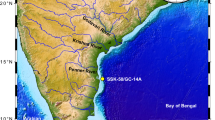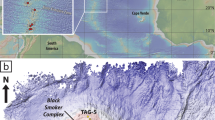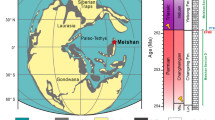Abstract
The resolution and reliability of magnetostratigraphy and reconstructed time series of geomagnetic field behaviour depend critically on where remanence is acquired and fixed in the sediment column and whether the magnetization is altered chemically after deposition. If authigenic magnetic minerals are formed at depth or if the magnetic carriers are changed after deposition, then the nature and timing of magnetic events can be affected by depth offsets in remanence acquisition and mixing of detrital and authigenic signals. Using palaeo- and rock-magnetic and sediment geochemical analyses, we have studied how early diagenesis affects the magnetic properties of suboxic hemipelagic sediments. Here, we report evidence of the formation of fine-grained authigenic magnetites near the commonly observed brown–tan-green colour boundary, which marks the transition from Fe-oxidizing to Fe-reducing conditions. We propose that biogenic magnetite, produced by magnetotactic bacteria, forms as part of the microbially mediated sequence of reactions involved in the oxidation of organic matter. The magnetite is created as a metabolic by-product of the microorganisms' use of iron redox transitions as a source of energy. Active magnetite formation appears to be restricted to a zone between the levels of nitrate and iron reduction.
This is a preview of subscription content, access via your institution
Access options
Subscribe to this journal
Receive 51 print issues and online access
$199.00 per year
only $3.90 per issue
Buy this article
- Purchase on Springer Link
- Instant access to full article PDF
Prices may be subject to local taxes which are calculated during checkout
Similar content being viewed by others
References
Stumm, W. & Morgan, J. J. Aquatic Chemistry (Wiley, New York, 1970).
Claypool, G. & Kaplan, I. in Natural Gases in Marine Sediments (ed. Kaplan, I. R.) 99–139 (Wiley, New York, 1974).
Froelich, P. N. et al. Geochnim. cosmochim. Acta 43, 1075–1090 (1979).
Bemer, R. A. Early diagenesis, a Theoretical Approach (Princeton Press, New Jersey, 1980).
Lyle, M. Limnol. Oceanogr. 28, 1026–1033 (1983).
Hartmann, M., Müller, P. J., Suess, E. & van der Weijden, C. H. 'Meteor' Forshungsergeb. C24, 1–67 (1976).
Winters, G. V. & Buckley, D. E. Geochim. cosmochim. Acta 50, 277–288 (1986).
Jahnke, R., Heggie, D., Emerson, S. & Grundmanis, V. Earth planet. Sci. Lett. 61, 233–256 (1982).
Emerson, S. in The Carbon Cycle and Atmospheric CO: Natural Variations Archean to Present (eds Sunquist, E. & Broecker, W. S.) 78–87 (AGU Geophys. Monog. 32 Washington DC, 1986).
Blakemore, R. Science 190, 377–379 (1975).
Frankel, R. B., Blakemore, R. P. & Wolfe, R. S. Science 203, 1355–1356 (1979).
Stolz, J. F., Chang, S.-B. R. & Kirschvink, J. L. Science 321, 849–851 (1986).
Moench, T. T. & Konetzka, W. A. Archs. Microbiol. 119, 203–212 (1978).
Mann, S., Frankel, R. B. & Blakemore, R. P. Nature 310, 405–407 (1984).
Mann, S. in Magnetite Biomineralizalion and Magnetoreception in Organisms (eds Kirschvink, J. L., Jones, D. S. & MacFadden, B. J.) 311–332 (Plenum, New York, 1985).
Kirschvink, J. L. Earth planet. Sci. Lett. 59, 388–392 (1982).
Chang, S.-B. R. & Kirschvink, J. L. in Magnetite Biomineralization and Magnetoreception in Organisms (eds Kirschvink, J. L., Jones, D. S. & MacFadden, B. J.) 647–669 (Plenum, New York, 1985).
Petersen, N., von Dobeneck, T. & Vali, H. Nature 320, 611–615 (1986).
Graybeal, A. L. & Heath, G. R. Geochim. cosmochim. Acta 48, 965–975 (1984).
Lyle, M., Heath, G. R. & Robbins, J. M. Geochim. cosmochim. Acta 48, 1705–1715 (1984).
Kadko, D. Earth planet. Sci. Lett. 51, 115–131 (1980).
Klinkhammer, G. P. Earth planet. Sci. Lett. 49, 81–101 (1980).
Robbins, J. M., Lyle, M. & Heath, G. R. A Sequential Extraction Procedure for Partitioning Elements among Co-existing Phases in Marine Sediments, 84–93 (Oregon State Univ., 1983).
Kent, D. V. Science 299, 538–539 (1982).
Banerjee, S. K. & Moskowitz, B. M. in Magnetite Biomineralization and Magnetoreception in Organisms (eds Kirschvink, J. L., Jones, D. S. & MacFadden, B. J.) 17–41 (Plenum New York, 1985).
Lowrie, W. & Fuller, M. J. geophys. Res. 76, 6339–6349 (1971).
Johnson, H. P., Lowrie, W. & Kent, D. V. Geophys. J.R. astr. Soc. 41, 1–10 (1975).
Levi, S. & Merrill, R. T. J. geophys. Res. 90, 309–314 (1978).
Author information
Authors and Affiliations
Rights and permissions
About this article
Cite this article
Karlin, R., Lyle, M. & Heath, G. Authigenic magnetite formation in suboxic marine sediments. Nature 326, 490–493 (1987). https://doi.org/10.1038/326490a0
Received:
Accepted:
Published:
Issue Date:
DOI: https://doi.org/10.1038/326490a0
This article is cited by
-
Chirality-induced avalanche magnetization of magnetite by an RNA precursor
Nature Communications (2023)
-
The assessment of heavy metal pollution in river sands of Jalingo, Nigeria using magnetic proxy parameters, pollution, and ecotoxicological indices
Acta Geochimica (2022)
-
Environmental magnetic and textural characteristics of two estuarine core sediments from Bay of Bengal, India
Arabian Journal of Geosciences (2021)
-
Magnetic intensity loss and core diagenesis in long-core samples from the East Cortez Basin and the San Nicolas Basin (California Borderland)
Earth, Planets and Space (2014)
-
Rock-magnetic changes with reduction diagenesis in Japan Sea sediments and preservation of geomagnetic secular variation in inclination during the last 30,000 years
Earth, Planets and Space (2014)
Comments
By submitting a comment you agree to abide by our Terms and Community Guidelines. If you find something abusive or that does not comply with our terms or guidelines please flag it as inappropriate.



